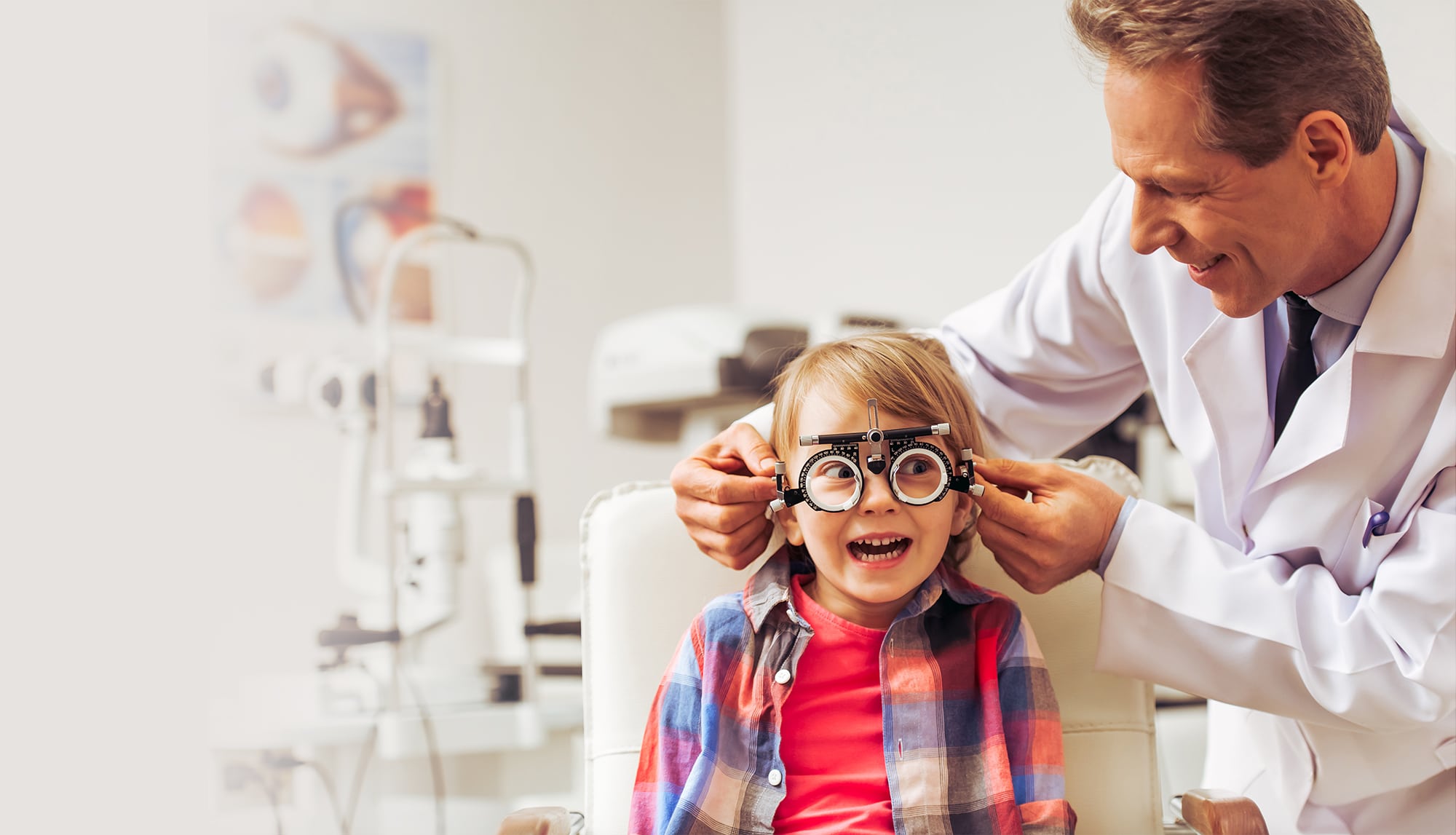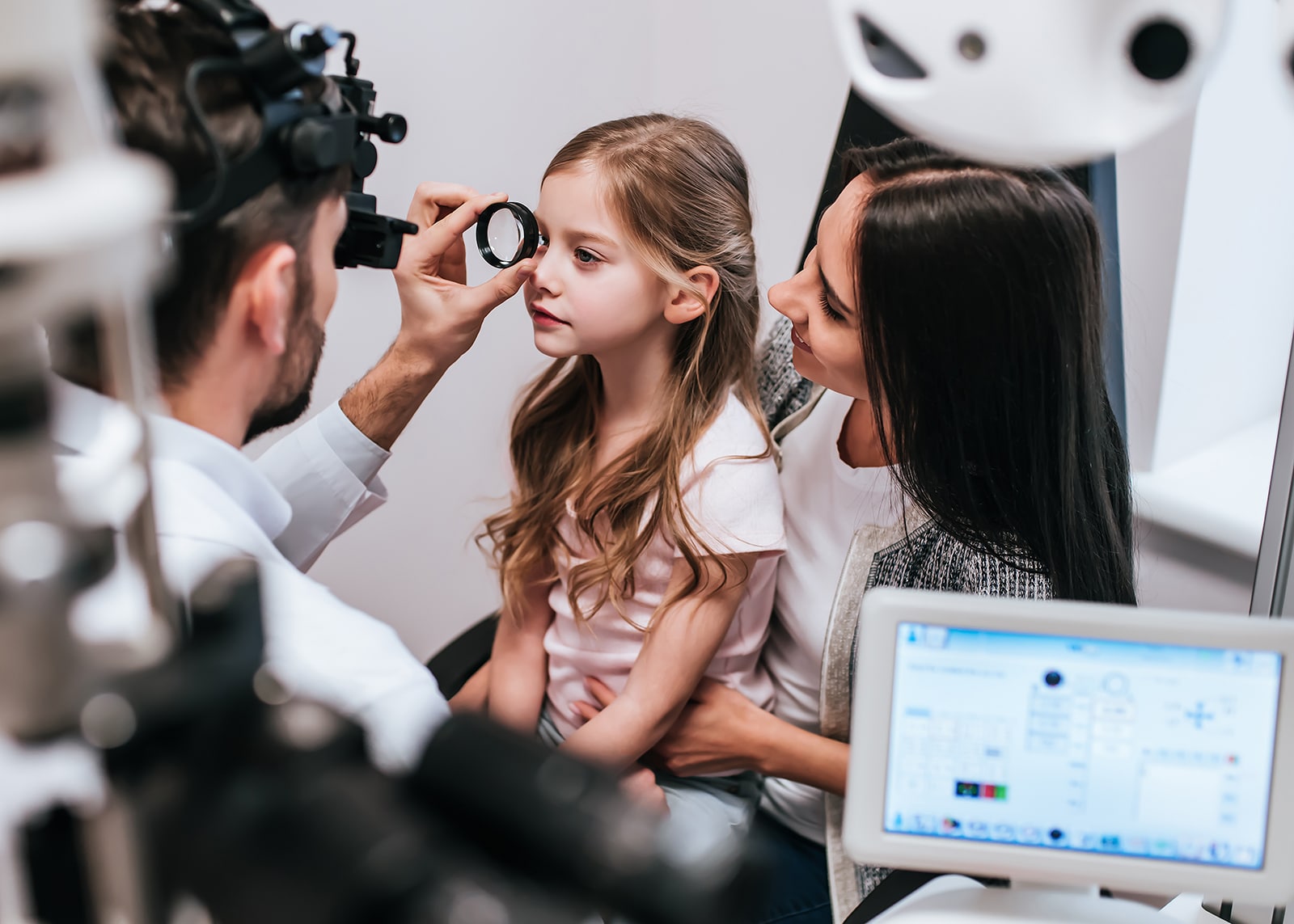
At Blaine Eye Clinic, our optometrists believe that monitoring visual and ocular health starts in infancy and continues well past adulthood. You only get one set of eyes, we want to ensure that they’re being taken care of. And we want to start that care early.
Our pediatric optometrists follow the advice of the American Optometric Association and advise a patient’s first eye exams happen before a patient’s first birthday, anywhere from ages 6 months to a year, again at ages 3 and 5, and then yearly after that to ensure that vision develops normally and that they are seeing their best. Routine follow up is crucial so that our staff can identify visual concerns and intervene as soon as necessary, if needed.
Our pediatric optometrists follow the American Optometric Association’s recommendations and advise an infant exam somewhere between 6-12 months. If the exam shows any concerns, your doctor will follow-up accordingly. Otherwise, their next exam will be at 3 years old and again at age 5 before school starts.
As you can imagine, a child’s exam looks a lot different than your comprehensive eye exam as an adult. We would love for you to read below to understand all the steps we take to provide that same level of care and thoroughness in our pediatric exams so that you leave our clinic reassured that your child’s vision is developing normally.

At Blaine Eye Clinic, our eye doctors specialize in the diagnosis and treatment of a variety of eye conditions that can affect children. Although there are many eye conditions that can develop in childhood, the most common vision issues present in children are refractive errors, amblyopia, and strabismus.
Refractive errors are one of the most common eye conditions in children and adults. Refractive errors, such as myopia (nearsightedness,) hyperopia (farsightedness,) and astigmatism, can often be corrected through glasses or contact lenses.
Amblyopia, also known as lazy eye, is a condition in which one of the eyes doesn’t develop clear vision. When this happens, the brain starts to tune out the weaker eye and put forth all its effort in relying on visual clarity provided by the stronger eye. This reliance on the stronger eye can cause decreased vision out of the weaker eye over time. Sometimes this can result in a “wandering eye” or “eye turn.” The sooner a patient receives intervention to correct this condition, the more likely clear vision will develop out of both eyes and the less likely an eye turn will develop. Treatment options for amblyopia includes patching, prescription drop therapy, glasses and vision therapy. Each of these treatment options aim to strengthen the weaker eye; however, it’s also worth noting that even with intervention early on, sometimes amblyopia will still be present. In more severe cases, surgery may be necessary. If warranted, our optometrists are happy to make a referral to a trusted pediatric ophthalmologist to discuss surgical options that will encourage the best possible visual outcome.
Strabismus is another common eye condition in children that affects eye alignment. If your child has strabismus, their eyes may turn in, out, up, or down due to a problem with the eye's muscles. Early diagnosis of this eye condition is necessary to prevent vision loss that can occur if strabismus is left untreated. To treat strabismus, eye doctors use similar techniques to those used to treat amblyopia. Your child’s eye doctor may use eye patch therapy or glasses to help strengthen the muscles and align the eyes. As with amblyopia, for severe cases, strabismus surgery may be necessary to correct eye alignment permanently.
A few of the visually integrated skills that support good physical development throughout childhood are balance, coordination, and focus. Depending on your child’s age, how they test for these developments vary, and our staff will use those various testing methods to ensure we’re catching any possible concerns as soon as we can.
Having a thorough health history is our first step. The optometrists and their staff will ask parents/guardians about any visual concerns, including but not limited to:
They will also ask about any pertinent health history that is being monitored by your child’s primary care physician, including issues related to premature birth, post-concussion symptoms, and Type 1 diabetes, to name a few. Gathering this health history ensures that our doctors know how to best check for symptoms and proceed forward with different correction and treatment options if deemed necessary. During this time, it is important that you are open and honest with any signs of visual struggles you may be noticing.
Make an Appointment
With children, our pediatric optometrists are trained to take objective measurements by using the tools necessary, including music videos and handheld toys, if subjective measurements are unattainable. Our testing strategies along with the equipment our doctors use allow us to get accurate measurements that can check for all possible concerns to make sure we’re taking care of your child’s current and future visual needs. And we do this by doing our best to make sure your child is comfortable during the duration of their visit with us.
Our doctors will make sure that children are able to “fix and follow” or visually perceive an object. We can check for peripheral vision concerns by having your child focus on an object in front of them and presenting visual stimuli in the corners of their vision. These same stimuli will be used to check eye movements and whether muscles responsible for eye movement have developed appropriately. Using lights, they are able to determine eye alignment to rule out strabismus.
Adaptations to normal testing might be made to better meet your child’s needs, such as reading off numbers or shapes instead of letters to check visual acuity. Equipment such as a retinoscope might be used to obtain a refractive error. The retinoscope helps doctors take objective measurements when a child may not be able to answer which lens makes vision seem clearer, 1 or 2.
Though it is no one’s favorite, dilation is still something we encourage for all our patients, including kids. Dilation helps us confirm prescription needs based on your child’s refractive errors as well as allowing the doctor to get a full retinal health check. The only way to rule out back of their eye health concerns is with dilation. Our staff at Blaine Eye Clinic know this can be a challenge but are trained in drop and spray installation techniques to make the dilation process as smooth as possible.
By taking all of these steps, we make sure that by the end of your visit with our team we have done all that we can to check out any areas of concern, answer any questions you may have, and give you guidance when it comes to how to best follow up in the future so that your child can have the best possible sight for years to come.
Make an AppointmentSchedule an appointment for your child at Blaine Eye Clinic in Blaine, MN, today!
Make an Appointment